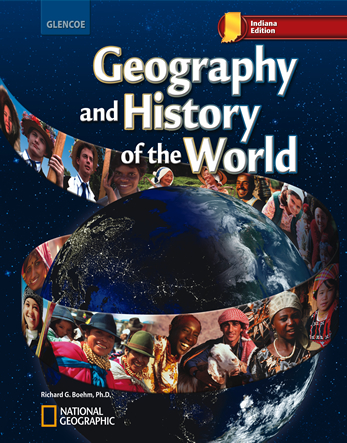

Geography and History of the World © 2010 Indiana EditionChapter 18: Cultural Geography of North Africa, Southwest Asia, and Central AsiaChapter OverviewsThe broad ethnic diversity of North Africa, Southwest Asia, and Central Asia stems from several early civilizations and three major world religions that evolved in the region. Later control by outside powers and the nationalistic movements that followed have strengthened this diversity. As a result, the region experiences cultural and political challenges today.North Africa North Africa has a European influence in the coastal regions, but the primary influence of the region is a mix of indigenous and Arab culture. Water is scarce in the region, so most people settle around sources of water such as seacoasts and rive deltas. North Africa has been the center of many invasions from Europe and the Arabian Peninsula. Arabs invaded in the seventh century. Europeans colonized the region in the mid 1800s. Geometric boundaries caused conflict after independence. Most North Africans are Sunni Muslims. Art is influenced by early Egyptian, and modern Islamic influences. The Eastern Mediterranean Most of the people in this subregion are Arab, although the nation of Israel is mostly Jewish. Most people live along coastal plains and the Euphrates river valley. It is predominately urban. The Eastern Mediterranean is the birthplace of three major religions: Judaism, Christianity, and Islam. Europe colonized the region in the 1900s. The countries gained independence around World War II. The U.N. divided Palestine into a Jewish state and an Arab state. Arab opposition to the Jewish state of Israel led to a series of conflicts. The status of the Palestinian Arabs has been left undecided during the conflicts. The culture of the region is influence by Judaism, Christianity, and Islam. The Northeast The people of the Northeast subregion come from Central Asia and the Arabian Peninsula. Large cities and towns are common, but population density varies country to country. Mesopotamia is one of the world’s first culture hearths. It arose in the rich agricultural region of the Fertile Crescent. The Sumerians, Phoenicians, Persian Empire, and Ottoman Empire all developed in this area. Western Europe controlled much of the Northeast by the late 1800s. After WWI colonization came to an end. After oil was discovered and production capacities developed, the region gained a large amount of wealth. The countries are all Islamic, but different branches are more common in different countries. The Arabian Peninsula Most people in the subregion are Arabic, however, there are many South Asians living in the Arabian Peninsula as temporary workers. The harsh desert and lush coasts dictate where people live. Because of the harsh climate of the subregion, large civilizations didn’t exist until the 1700s. The Saudi’s fought off the Ottoman Empire and established itself as a kingdom in 1932. Other nations looked to Great Britain for protection and was under its control until the 1960s. After independence standards of living varied dramatically based on whether the nations had significant oil wealth. The subregion is home to the two holiest cities in Islam, and all Muslims must make a pilgrimage to Makkah at least once. Islamic architecture and Islamic art can be found throughout the region. Central Asia This subregion is home to multiple ethnic groups. It sits on the crossroads of Asia. Due to its mountainous terrain the population of Central Asia is spread out unevenly. The Silk Road, passing from China to the Mediterranean passed through Central Asia, making trading cities such as Samarqand wealthy. Various empires such as the Mongols, Alexander the Great, Persians, Arabs, and Ottoman Turks have unified the region. Many Central Asian countries were part of the Soviet Union, and declared their independence when it collapsed. After the terrorist attacks of September 11, 2001, the U.S. overthrew the government of Afghanistan that sheltered Osama bin Laden. Most people in the region speak Turkic languages. Islam is the predominate religion. There is a rich literary tradition in the region. |  |















